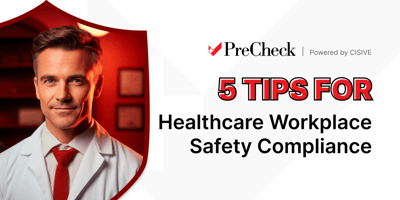

The Occupational Safety and Health Administration (OSHA) governs workplace safety conditions for...

Creating a safe and supportive environment in healthcare settings is crucial — not just for patients, but for the caregivers responsible for their well-being. As a healthcare leader, you know that the challenges are unique and multifaceted. Psychological safety in healthcare is more than just workplace safety. It’s about making sure caregivers feel free to speak up, take risks, and work together without fear of punishment or judgment.
Psychological safety has significant outcomes for patient care. Research shows that psychological safety fosters an environment where healthcare workers can collaborate effectively. Better-functioning teams drive better patient care, reduce medical errors, and improve treatment outcomes.
Let’s take a look at the importance of psychological safety in healthcare including why it is so vital and how you can cultivate it within your organization.
Psychological safety in healthcare is about creating an environment where every team member feels comfortable, valued, and able to contribute without fear. It’s not just avoiding harm — it’s actively fostering a workplace where open communication thrives and everyone feels secure in speaking up. One study found that signs of psychological safety on healthcare teams include support, learning, voice, and familiarity.
Supportive leadership plays a huge role here. When leaders are inclusive and approachable, it sets the tone for a workplace where staff feel confident sharing their thoughts and concerns. Your role as a leader is to listen actively, respond constructively, and show that every opinion matters.
Good relationships among team members are also key for ongoing learning. Trust and support among team members creates a sense of belonging that encourages open communication, allowing team members to discuss errors without fear of retaliation. “We need to really frame errors as learning opportunities,” says Cisive CHRO Linda Ballard. Building these relationships can be as simple as regular team interactions, where everyone feels respected and included.
It’s also crucial that your team knows they can speak up without fear of negative consequences. Whether it’s raising a concern or admitting a mistake, healthcare workers need to feel that their voice isn’t just heard but valued. As a leader, fostering this open dialogue is essential. “Employees need to feel like they have a safe space [to admit], ‘I need more shadowing. I need more training. I need more practice,’ and not be retaliated against or made to feel like they’re inadequate to their peers,” Linda says.
Finally, trust within the team is built on familiarity. When team members know and understand each other, they collaborate more effectively and feel safer expressing themselves. Encourage regular interactions and teamwork to build this trust, making psychological safety a natural part of your healthcare environment.
By focusing on these elements, you create a workplace where psychological safety is more than just an idea — it’s a reality that both improves performance and patient safety.
When we talk about psychological safety in healthcare, we must recognize the unique challenges healthcare professionals face daily. Unlike many other industries, healthcare workers deal with life and death situations, making the stakes extraordinarily high. The pressures of delivering quality care, often under time constraints and in emotionally charged environments, create a breeding ground for stress, burnout, and errors. These challenges require a thoughtful and proactive approach to ensure psychological safety.
Burnout is an epidemic in the healthcare industry, exacerbated by healthcare worker shortages and the extreme demands placed on caregivers. Long hours, emotional exhaustion, and the relentless pressure to maintain high patient satisfaction scores contribute to a workforce that’s overworked and overwhelmed. This burnout doesn’t just affect the well-being of healthcare workers; it directly impacts patient care. When caregivers are burnt out, they can’t give good care. This can lead to mistakes and less satisfaction with patients.
To combat this, you must recognize the signs of burnout early and address them head-on. Implementing strategies such as regular check-ins, workload management, and providing access to mental health resources can make a significant difference. By prioritizing the well-being of your staff, you indirectly enhance the quality of care they provide.
Trust and transparency are the foundation of psychological safety. In healthcare, where every action can have a significant impact on patient outcomes, fostering an environment where staff feel safe to speak up is crucial. Make sure that your team knows they can raise concerns, report errors, or ask for help without fear of blame or retribution.
Building trust starts with leadership. Be open, honest, and approachable. When mistakes happen — and they inevitably will — frame them as learning opportunities rather than occasions for punishment. This approach not only builds trust but also encourages continuous learning and improvement. Remember, transparency in your actions and communications sets the tone for your entire team.
Creating a culture where psychological safety is embedded into the fabric of your organization requires deliberate effort and commitment. It’s about more than just policies; it’s about changing mindsets and behaviors at all levels of the organization.
As a leader, you are the catalyst for change. Your actions, decisions, and attitudes set the precedent for what is acceptable within your organization. To foster psychological safety, you must lead by example. Show your team that it’s okay to make mistakes, ask questions, and seek support. By modeling these behaviors, you create an environment where your staff feels secure in doing the same.
“You have to build that trust,” Linda says. “You have to build that visibility and have that outreached hand to help them and guide them through very challenging healthcare situations.”
Additionally, providing training for leadership on how to support psychological safety is essential. Leaders must be equipped to recognize signs of distress, facilitate open communication, and create a supportive work environment. Your commitment to these principles will inspire your team to follow suit.
Encouraging your staff to voice their concerns or ideas is a fundamental aspect of psychological safety. Yet, many healthcare workers hesitate to speak up, fearing negative consequences. It’s your responsibility to break down these barriers.
Create multiple channels for communication — formal and informal — where staff can voice their thoughts without fear. Regularly reinforce the message that all contributions are valued, and reiterate that there are no repercussions for raising concerns. Empowering your staff to speak up not only improves psychological safety but also fosters a culture of innovation and continuous improvement.
Policies and practices that support psychological safety are non-negotiable. This includes implementing clear protocols for reporting incidents, providing access to mental health resources, and checking that workloads are manageable. Regularly review and update these policies to reflect the evolving needs of your workforce.
Moreover, consider establishing peer support programs or mentorship opportunities. These initiatives provide healthcare workers with the support they need to navigate the challenges of their roles, further enhancing psychological safety.

Now that you understand the importance of psychological safety in healthcare, let’s explore some practical initiatives you can implement to support your healthcare staff. These initiatives focus on daily practices that promote well-being, continuous learning, and a supportive work environment.
Regular check-ins and debriefing sessions are powerful tools for maintaining psychological safety. These sessions provide a structured environment where staff can reflect on their experiences, share concerns, and offer feedback.
Encourage open dialogue during these sessions. Ask questions like, “What went well today?” and “What could we improve on tomorrow?” This not only helps identify areas for improvement but also reinforces the message that every voice matters.
Mentorship programs are invaluable for fostering psychological safety. Pairing less-experienced staff with experienced professionals provides them with the guidance and support they need to navigate their roles with confidence.
In addition to mentorship, offer continuous learning opportunities. This could be through formal training, workshops, or even on-the-job shadowing. When staff feel equipped with the knowledge and skills they need, they’re more likely to take initiative and less likely to feel overwhelmed by their responsibilities.
Encouraging self-care and work-life balance is critical in preventing burnout and maintaining psychological safety. Promote the importance of taking breaks, setting boundaries, and engaging in activities outside of work that foster well-being.
Consider implementing policies that support work-life balance, such as flexible scheduling or offering resources for stress management. When your staff feels that their well-being is a priority, they are more likely to be engaged, productive, and committed to providing high-quality care.
Something as simple as asking teams for a minute or two of quiet at the beginning of a meeting can go a long way, Linda says, recalling one case manager who did just that. “She had their minds rest for a minute before they started talking, because she she was under the impression that if she didn’t slow them down for a minute and focus on their well-being, that she would lose their trust — and she was right.”

The benefits of prioritizing psychological safety in healthcare extend far beyond the immediate work environment. When your staff feels supported and safe, the positive impacts ripple through the entire organization, ultimately leading to better patient outcomes.
Psychological safety is directly linked to improved patient outcomes. When healthcare workers feel safe to speak up about potential issues, errors are caught earlier, and care plans can be adjusted in real-time. This proactive approach leads to higher-quality care, fewer mistakes, and, ultimately, greater patient satisfaction.
Moreover, when caregivers feel supported, they can focus more on patient care rather than being preoccupied with workplace stressors. This attention to detail and compassionate care significantly improves the patient experience.
A psychologically safe workplace is a more engaging one. When staff feel valued, heard, and supported, their commitment to the organization grows. This increased engagement not only leads to better performance but also improves employee retention rates.
In an industry where turnover is high, especially post-pandemic, retaining skilled staff is crucial. By creating a culture of safety, you make employees want to stay and grow. This will reduce the costs and disruptions of turnover.
Innovation thrives in environments where people feel safe to take risks and propose new ideas. When your staff knows that their suggestions will be met with openness rather than skepticism, they’re more likely to contribute innovative solutions.
This culture of continuous improvement is essential in healthcare, where progress in care practices can save lives. By encouraging your team to think creatively and collaboratively, you position your organization at the forefront of healthcare innovation.
Maintaining psychological safety is an ongoing process. It requires vigilance, adaptability, and a commitment to continuous improvement. Here’s how you can overcome the challenges and sustain a culture of psychological safety in your organization.
Systemic issues in healthcare, such as understaffing, inadequate resources, and rigid hierarchies, can undermine psychological safety. Addressing these issues requires both short-term and long-term strategies.
In the short term, make sure that your staff has the resources they need to perform their jobs effectively. This might mean advocating for more staff, securing additional funding, or streamlining processes to reduce unnecessary burdens.
In the long term, work towards systemic change by collaborating with other leaders in the healthcare industry. Advocate for policies that prioritize psychological safety and well-being at all levels of the healthcare system.
Psychological safety isn’t a one-time initiative; it requires sustained effort. Regularly assess the state of psychological safety in your organization through surveys, focus groups, or one-on-one meetings.
Hold yourself and your leadership team responsible for maintaining this culture. Celebrate successes, but also be willing to address areas where improvement is needed. By keeping psychological safety at the forefront of your organizational priorities, you can make sure that it remains a vital part of your workplace culture.
The healthcare environment is dynamic, with new challenges constantly emerging. To sustain psychological safety, you must be adaptable. This means regularly revisiting and adjusting your practices and policies to meet the evolving needs of your staff.
Stay attuned to the changes in your organization and the broader healthcare landscape. Be proactive in addressing new challenges and be open to feedback from your team on how best to support them.
As a leader, you have the power to create an environment where your staff feels valued, supported, and empowered to provide the best possible care. “You are the role model,” Linda says. “You reinforce that psychological safety for your team members.”
By prioritizing psychological safety in healthcare, you not only improve the well-being of your caregivers but also improve patient outcomes, foster innovation, and build a resilient, engaged workforce. The challenges are significant, but the rewards are immense.
Start today by taking the steps outlined here, and you’ll see the positive impact on your organization and the lives of those you serve.
Want to learn more about maintaining safety in healthcare settings? Schedule a call with one of our background screening experts.
Author: Jenni Gallaway
Bio: Content Marketing Manager at Cisive. 8 years of experience in the background screening industry.
Let's Connect on LinkedIn
The Occupational Safety and Health Administration (OSHA) governs workplace safety conditions for...

Healthcare background check compliance is a critical component of the hiring process. Who you hire...

Every surgery, treatment, medication, and provider hiring decision has inherent risks, from...